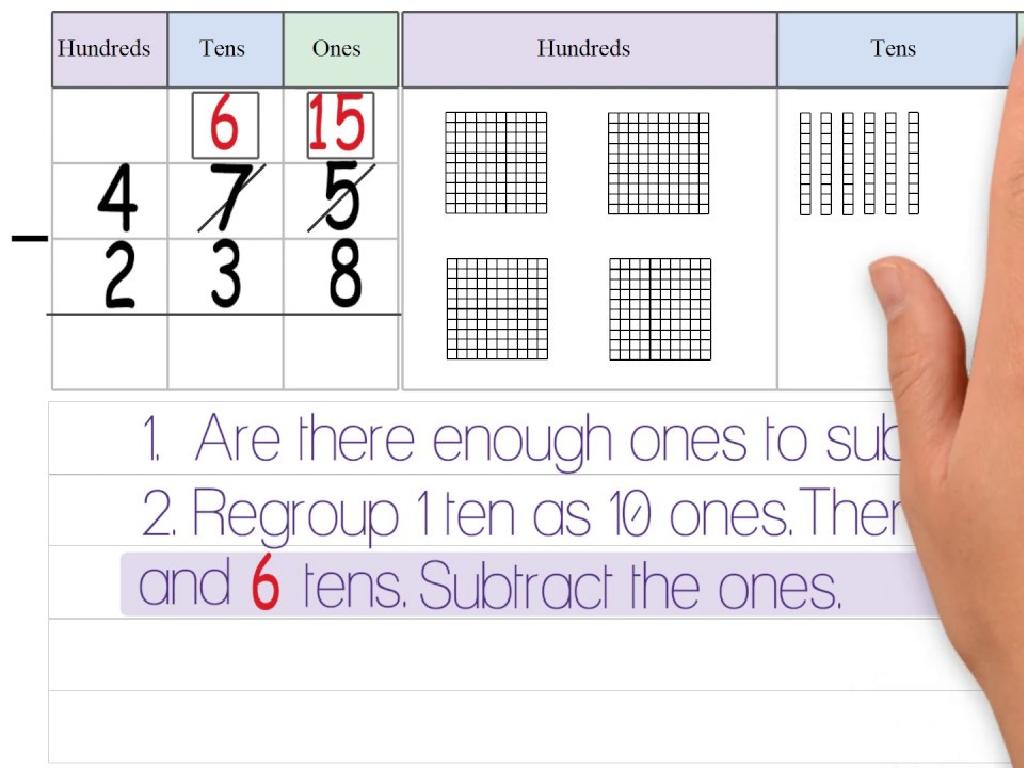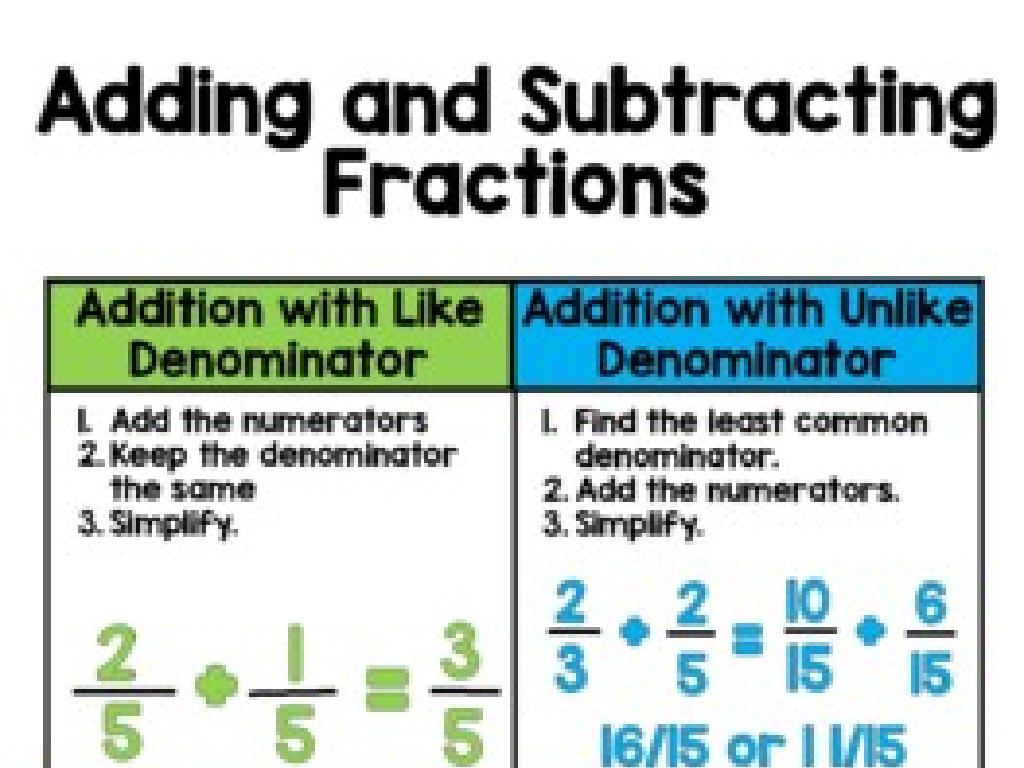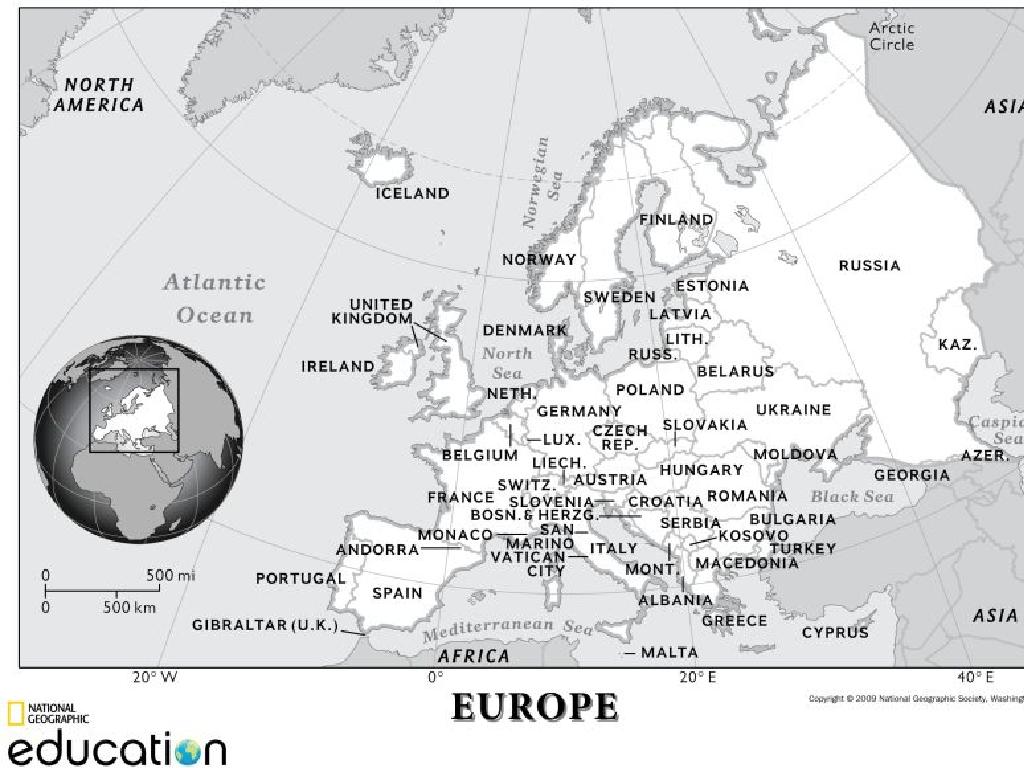Equivalent Decimals
Subject: Math
Grade: Fifth grade
Topic: Compare Decimals
Please LOG IN to download the presentation. Access is available to registered users only.
View More Content
Exploring Equivalent Decimals
– Quick recap on decimals
– Decimals represent parts of a whole
– ‘Equivalent’ in math
– Equivalent means equal in value or amount
– Finding equivalent decimals
– Use division or multiplication to find equivalents
– Examples of equivalent decimals
– 0.50 is the same as 0.5 or 1/2
|
Begin with a brief review of what decimals are and how they represent fractions of a whole number. Explain the term ‘equivalent’ as it pertains to mathematics, meaning two values that are the same even if they look different. Teach students how to find equivalent decimals by multiplying or dividing by powers of 10. Provide clear examples, such as showing that 0.50 is equivalent to 0.5 because both represent half of a whole. Encourage students to think of other examples and to understand that equivalent decimals are just different ways of expressing the same value.
Understanding Decimals
– Decimals represent fractions
– Decimals show parts of a whole, like 0.5 for 1/2
– Parts of a decimal explained
– A decimal has two parts: a whole number and a fractional part, e.g., 2.3
– Reading decimals with place value
– Each place after the decimal has a value: tenths, hundredths, etc.
– Practice decimal conversion
|
This slide introduces the concept of decimals to fifth graders, explaining that decimals are another way to express fractions. Emphasize that the decimal system is based on the number 10, and each place value represents a power of 10. The whole number is to the left of the decimal point, and the decimal part is to the right, which represents the fractional part of the number. Use examples to show how place value works, such as 0.3 being 3 tenths, and 0.03 being 3 hundredths. Encourage students to practice converting fractions to decimals and vice versa to solidify their understanding.
Understanding Equivalent Decimals
– What are equivalent decimals?
– Decimals that represent the same amount, like 0.50 and 0.5
– Examples of equivalent decimals
– 0.25 is the same as 0.250, and 0.60 equals 0.6
– The value equivalence concept
– Despite different appearances, they have the same value
– Significance of equivalent decimals
– It’s crucial for accurate math calculations and comparisons
|
This slide introduces the concept of equivalent decimals, which are different decimal numbers that represent the same value. For example, 0.50 and 0.5 may look different but they are the same amount. It’s important to provide students with clear examples, such as 0.25 and 0.250, to illustrate that additional zeros do not change the value. Understanding this concept is vital for students as it forms the basis for accurate mathematical calculations and comparisons, especially in more advanced topics like algebra. Encourage students to practice with various examples to become comfortable with identifying equivalent decimals.
Finding Equivalent Decimals
– Multiplication for equivalent decimals
– Multiply by 10, 100, or 1000 to find equivalents
– Division for equivalent decimals
– Divide by 10, 100, or 1000 for equivalents
– Practice: Convert 0.5 to equivalent
– Example: 0.5 x 10 = 5.0 or 0.5 x 100 = 50.0
|
This slide aims to teach students how to find equivalent decimals using multiplication and division. Start by explaining that multiplying or dividing a decimal by 10, 100, or 1000 shifts the decimal point to the right or left, creating an equivalent decimal. Provide a practice example by converting 0.5 into an equivalent decimal. Show that multiplying 0.5 by 10 gives 5.0, which is the same value in a different form. Emphasize that the value doesn’t change, only the way it’s written. Encourage students to try with different multipliers and dividers to see the pattern. This will help solidify their understanding of place value and decimals.
Comparing Decimals
– Steps to compare decimals
– Line up the decimals, then compare digits from left to right.
– Use place value for comparison
– Place value helps us see which decimal is larger or smaller.
– Activity: Order decimals
– Arrange a set of decimal numbers from the smallest to the largest value.
|
This slide introduces the concept of comparing decimals, which is a fundamental skill in understanding numerical values. Start by explaining the importance of aligning decimal points and comparing digits starting from the highest place value, moving to the right. Emphasize that place value is crucial in determining the size of the number. For the activity, provide students with a list of decimal numbers and instruct them to write them in order from the smallest to the largest. This will help solidify their understanding of decimal place values and comparison. Possible activities could include using number lines, comparing prices, or measuring items to the nearest tenth or hundredth. Ensure that each student has a chance to practice and that they understand why one decimal is greater or less than another.
Class Activity: Discovering Equivalent Decimals
– Pair up for a decimal match
– Share findings with the class
– Complete the worksheet
– Match each decimal with its equivalent fraction or decimal
– Discuss the concept of equivalence
– Understand that different decimals can represent the same value
|
This interactive class activity is designed to help students understand the concept of equivalent decimals through collaboration and discussion. Students will pair up and work together to match decimals with their equivalent fractions or other decimal forms on a provided worksheet. After completing the activity, pairs will share their findings with the class, fostering a collaborative learning environment. The teacher should circulate the room to assist and guide discussions, ensuring that students grasp that despite appearing different, some decimals represent the same value. Possible activities include matching decimals to fractions, finding equivalent decimals for given numbers, and using visual aids like decimal grids or number lines to compare values.
Real-Life Applications of Equivalent Decimals
– Understanding money: dollars and cents
– $1.00 is equivalent to $0.100, understanding this helps with money management.
– Measuring lengths: meters and centimeters
– 1.5 meters is the same as 1.50 meters, crucial for accurate measurements.
– Comparing prices while shopping
– Reading and interpreting measurements
– Knowing that 1.200m is the same as 1.2m ensures correct interpretation of lengths.
|
This slide aims to show students how equivalent decimals are used in everyday life, emphasizing the practicality of understanding this concept. When dealing with money, it’s important to recognize that $1.00 and $0.100 are the same, which is essential for financial literacy. In measurements, understanding that 1.5 meters is equivalent to 1.50 meters is crucial for accuracy in science and everyday tasks. Encourage students to think of times they’ve compared prices or measured something, and how knowing equivalent decimals made that easier. Discuss how this knowledge is not just for math class but is a skill they’ll use throughout their lives.
Class Activity: Equivalent Decimals Scavenger Hunt
– Find items with price tags
– Match prices to equivalent decimals
– For example, $1.50 is the same as $1.5
– Share findings with classmates
– Reflect on the activity
– Discuss what you learned about decimals
|
This interactive class activity is designed to help students understand the concept of equivalent decimals in a fun and engaging way. Students will search for objects around the classroom or school that have price tags on them. They will then match those prices with equivalent decimal values, reinforcing the idea that decimals can be expressed in different forms but represent the same value. After the scavenger hunt, students will gather and share their findings, allowing them to see the variety of ways decimals can appear in everyday life. As a teacher, prepare a list of items with price tags beforehand and ensure there are enough examples for the entire class. Consider pairing students to promote teamwork. After sharing, lead a discussion on the importance of understanding decimals in real-world contexts.
Wrapping Up: Equivalent Decimals
– Review of equivalent decimals
– Significance of equivalent decimals
– They help in understanding the value of numbers and in comparing decimals.
– Homework: Practice worksheet
– Complete the worksheet to reinforce today’s lesson.
– Encourage questions and discussions
– Share any difficulties or insights you’ve had.
|
As we conclude today’s lesson on equivalent decimals, it’s important to recap the key points. Understanding equivalent decimals is crucial for comparing different decimal numbers and for grasping the concept of value in our number system. For homework, students are assigned a practice worksheet that will help solidify their comprehension of today’s material. Encourage students to ask questions if they’re unsure about any part of the lesson and to discuss any interesting observations they’ve made. This will help ensure that they are well-prepared for the next class and have a strong grasp of the concept of equivalent decimals.





